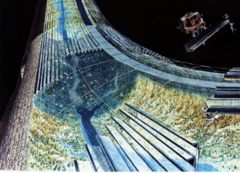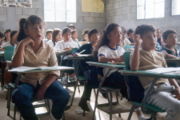Difference between revisions of "Main Page"
| Line 19: | Line 19: | ||
<!-- ******* START OF RIGHT COLUMN ******* --> | <!-- ******* START OF RIGHT COLUMN ******* --> | ||
<div style="float:right; width:49%"> <!-- This margin should be right of the above --> | <div style="float:right; width:49%"> <!-- This margin should be right of the above --> | ||
| − | |||
{{frame more1|Closed-loop automation}} | {{frame more1|Closed-loop automation}} | ||
| + | {{frame more1|Automated infrastructure}} | ||
{{frame more1|Education}} | {{frame more1|Education}} | ||
{{frame1|Co-operation and collaboration}} | {{frame1|Co-operation and collaboration}} | ||
</div> | </div> | ||
{{portalpageend}} | {{portalpageend}} | ||
Revision as of 03:25, 19 November 2006
 Welcome to AdCiv.org :: Advanced Civilisation through Post Scarcity :: Post Scarcity through Open Design and Advanced Automation We are nowhere near the height of human civilisation.
Not even close. Our present culture is conditioned by centuries of scarcity that ought to have disappeared by now, considering our technical capabilities. However, automation is advancing rapidly, and in parallel, we are developing ever more effective ways of collaborating and openly sharing knowledge. This means it will become increasingly unacceptable to let needless scarcity continue in the face of what is possible. New thinking and tools are emerging that could change everything. Via the internet a new fluid grouping of minds is evolving that is adhoc, distributed and mutually sharing – a system that is potentially far more effective at problem-solving and creative technical development than anything that has come before. In some areas, notably software development and knowledge gathering, it is well under way – but this is just the beginning. These 'open' peer-to-peer activities are about to burst out into the physical world enabling us to do things both technologically and economically that have not previously been feasible. AdCiv.org is exploring the emerging possibilities, focusing on developing concepts that could take us to the next logical phase of civilisation – namely an ecologically sympathetic post-scarcity age where abundant resources, tools and knowledge could enable a unparalleled standard of living for the entire growing global population. It may sound far-fetched to the uninitiated but the technologies to enable this are developing rapidly, so you might want to prepare yourself... Open collaborative design involves applying principles from the remarkable free and open-source software movement that provides a powerful new way to design physical objects, machines and systems. All information involved in creating the object or system is made available on the Internet – such as text, drawings, photographs and 3D computer-aided design (CAD) models – so that other people can freely re-create it, or help contribute to its further evolution. It is essentially the same principle that is used to progress scientific knowledge, however in reality it is much more open and transparent than much of contemporary scientific research.
A core element of this development model is a principle called 'copyleft'  The post-scarcity age is an anticipated era where advanced automated technology combined with efficient use of natural resources and effective co-operation could create a great abundance of the material items, goods and services required by a global population. As these highly automated processes continue to evolve, the results are likely to be achieved with ever diminishing harm to the environment.
Mankind's ever-increasing technical sophistication, will mean that people should not have to die or suffer unnecessarily due to a lack of basic necessities like food, clean water and medicine which is still the case in many parts of the world; and additionally humanity can undertake projects that were previously impossible or economically unfeasible. Additionally due to this physical abundance society may lose some of its obsessive preoccupation with material possessions, meaning it could become a post-materialistic era also. This is hard to see while sitting in the middle of the current consumer culture and is a debatable point, but even if people's taste for goods does not subside, old goods will be easily recycled into new. It has been promised for decades but the technology and culture to enable a true era of abundance could finally free people from working in jobs they have no particular interest to them except for the wage that it gives. People would be free to pursue their interests, learn and have far more time to be with the people who are important to them. Among other things like personal happiness, this is vital in restoring genuine communities and all the richness and support that gives to those living within it. The bigger picture being painted here may sound rather idealistic, but the enormously powerful enabling technologies and co-operative frameworks that make it possible need to be properly understood in order for this to make any sense...  So what have we got to work with? Mankind's fundamental resources are material, energy, intelligence and information. In reality they are all so enormously abundant that it's incredible to think that there are people in this world who are still going without the basic human necessities.
In the past a lack of technology could be considered a significant cause of scarcity but that is certainly not a reason any more. Despite common perceptions, there is no actual lack of material or energy available to us. Emerging methods of co-operation and advanced automation have the potential to unlock these resources to provide a good standard of living in all parts of the world, while causing minimal harm to the natural environment - a combination that although is hard to imagine today and might appear at first glance to be contradictory, is very much possible. An important trend in technological progress is the tendency of products and processes to steadily become more effective while using less material and energy – i.e. doing more with less – something that Buckminster Fuller termed ephemeralization termed ephemeralization  . .  There really couldn't be anything more important to us than the survival of our own species. It means protecting ourselves and future generations. However we currently have all our eggs in one basket which is a precarious situation – we live on this single world while under the shadow of various apocolyptic threats, both man-made and natural, that could destroy our current civilisation and even wipe us out entirely. Ultimately we are extremely vulnerable. Asteroids, virulent disease, global war with advanced weapons – all are possible and we must protect our future.
We've come a long way and gained irreplaceable culture and knowledge in the last hundred thousand years or so, and it would be the most foolish thing in history to lose it at a time when we have the technology to do something about it. Far more likely than total annihilation of our species is the possibility of being knocked back to the Dark Ages. It is not just about surviving but having good prospects, opportunities and a rich environment to live in, and not messing things up for our descendants. It's quite tricky to have an advanced civilisation with no civilisation at all...
 Some people wonder what is the point of heading off into space when we have a wonderful planet to live on that provides all of our needs, and rather usefully has an atmosphere that we can breathe...
One reason is survival. At the moment we have all our eggs in one basket here on Earth. If nothing else, space colonization will be an insurance policy that will allow life to survive on other spaceships should something catastrophic happen to Spaceship Earth. It is also the next great step for life inhabiting a new environment and spreading itself ever wider - something it has been doing for the past 3.7 billion years. Freed from scarcity, Man tends to look for interesting challenges and ways to extend his horizons. What greater adventure could there be than extending life beyond our home planet and reaching out into the stars? On a more pragmatic note, the resources in space of energy, material and living space are effectively unlimited. This will allow our civilisation to constantly expand while taking the burden off the Earth. Just as the New World held the promise of abundant gold and land to settlers of the Americas, space is a frontier filled with unfathomable wealth of all kinds. Simultaneously, it holds the best promise to help ensure our survival, and the most interesting way to extend our reach. It should be a top priority. Advanced automation here refers to sophisticated automated systems, ideally with the additional capability for self-maintenance and repair, mostly requiring little or no human interaction to operate, apart from top-level guidance. Not being reliant on human effort to scale, these systems would hugely magnify our capability for production and decouple human time and effort from industrial productivity, allowing us to create as much of anything that is needed, while releasing people from mindless labour. This situation will arise when automated harvesting of raw materials is combined with automated logistics (already commonplace), automated transport systems, robotic manufacturing and self-maintenance and repair, creating fully automated production of useful goods.
In Western countries many industrial process are becoming highly automated already, but human effort is needed for construction and commissioning as well as maintenance and repair. In developing nations, there is not much automation at all due to labour being so cheap; however this is a great waste of human lives. These self-repairing systems are based on technologies and knowledge that we already possess. No fictional concepts or unattainable artificial intelligence are required to make this happen. We have the ability today to create systems that provide for the global population's basic needs and far beyond, while minimising our impact on the environment – these two aspects are not mutually exclusive. Automated infrastructure refers to the key infrastructure needed for advanced automation being a fully closed loop. These systems have the capacity to self-maintain and self-repair with little or no human intervention, keeping themselves in the condition and within the parameters set by the engineers. Systems such as transport networks, power generation, water treatment plants, mines, material processing plants, factories and other industrial systems. If these systems are all automated and interface with each other, the means for production for humanity will be ultimately efficient and scalable.
These complex systems can be developed using the power of open collaborative design, which has the additional benefit of giving transparency to their development. Having the industrial infrastructure fully automated means it can be easily scaled up to provide everything that the global population requires with ultimate flexibility, and it frees people up to do things that people are good at and want to do.
 Ignorance is a contributing factor in many of the problems we face today, such as AIDS, pollution and food production. A first-rate education for the citizenry synergizes
 with every other element of an advanced civilization: scientific discovery happens faster, open collaborative projects grow faster and at a better quality, public health improves, solutions to our problems come faster and ambitious projects like colonising space or curing cancer become more and more feasible. with every other element of an advanced civilization: scientific discovery happens faster, open collaborative projects grow faster and at a better quality, public health improves, solutions to our problems come faster and ambitious projects like colonising space or curing cancer become more and more feasible.
There is no reason whatsoever for education to be a scarce resource. Education is a resource of information, rather than of physical goods, and reproducing information is free. In a world of universal connectivity, education can be ubiquitous if it is made freely available online. This is a task for open collaboration. It is no secret that the schooling system nowadays is in a crisis. Our schools are based on a factory-line model: a child goes in one end, is processed according to a standard procedure and comes out the other end with a certificate. No regard is paid to the person's interests, curiosity, creativity, passion. Students are taught outdated material from a peculiar selection of often irrelevant or downright boring subjects. Their flexibility and capacity to deal with unexpected, non-obvious solutions are not encouraged, and are often actively suppressed. They are not free to pursue their passions and talents. They are not given the chance to apply their skills in any practical way. And worst of all, most students simply hate school. (One study [1] found that only 10-33% of students report being satisfied with school. The same study found that most students feel their teachers are uninterested in supporting them.) How can we promote better education? The answer seems simple: make learning truly interesting, more relevant to the individual and make proper use of modern media. An inflexible curriculum only benefits the schools and assessment bodies. It is becoming ever easier to create interactive 3-D environments such as those found in advanced computer games. With the right scripting for interaction and behaviour, these can make a captivating experience where the student hardly realises they are learning. It is a crime for education not to be interesting! Luckily, for every module of every subject there are educators (and others) who are truly gifted at explaining and teaching key concepts. We must make better use of these people in conjunction with open collaboration and the latest technology to disseminate knowledge to all who wish to learn, wherever they might be in the world.  |
 [print version]
[print version]  [update]
[update]  [site map]
[site map]









